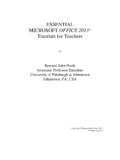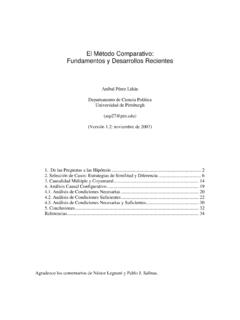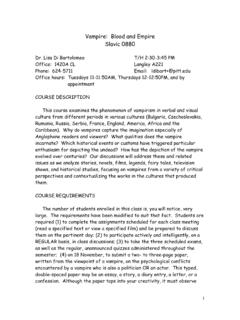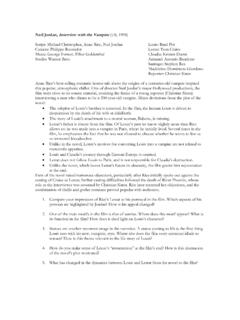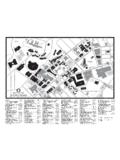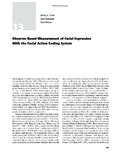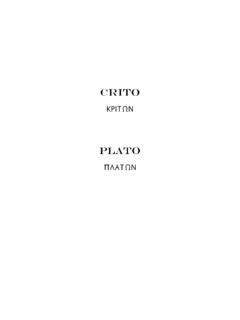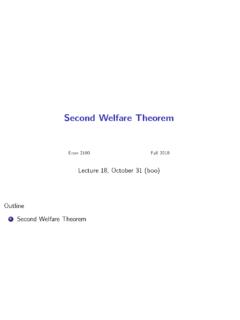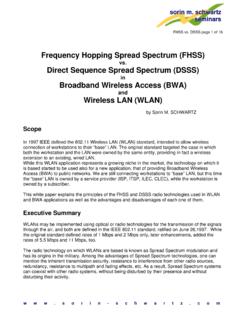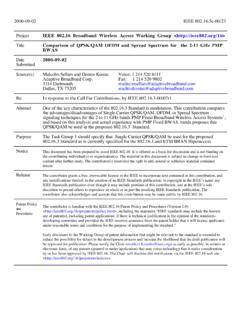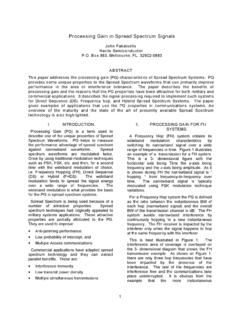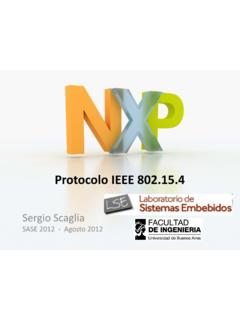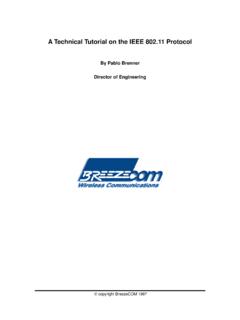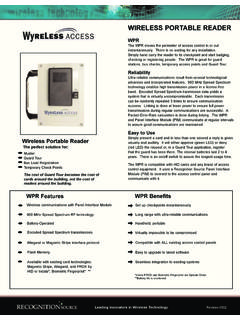Transcription of IS-95 CDMA
1 1 ISIS--95 (95 (cdmaonecdmaone))David TipperAssociate ProfessorAssociate ProfessorGraduate Telecommunications and Networking Program University of PittsburghSlides 9 ~ ~ 27202IS-95 CDMA IS-95 (cdmaone) 2G digital cellular standard Motivation Intended as a new system (greenfield) or replacement for AMPS (not an upgrade) Increase system capacity Add new features/services History: 1990 Qualcomm proposed a code division multiple access (CDMA) digital cellular system claimed to increase capacity by factor 20 or more Started debate about how CDMA should be implemented and the advantages vs. TDMA (religious tones to debate) 1992 TIA started study of spread spectrum cellular2 TELCOM 27203IS-95 CDMA (cont) Several alternative CDMA proposals floated large debate in the CTIA came down to Interdigital vs. Qualcomm Qualcomm proposal won 1993 TIA IS-95 code division multiple access (CDMA) standards completed 1995 IS-95A enhanced revision ANSI J-STD-008 (IS-95b) is standard upbanded to 1900 MHz PCS band 1996 Commercial deployment in US (Sprint PCS) Most popular system in and Korea 1997 IS-95 name changed to cdmaone IS-95 evolves to cdma 2000 in and 3 GTELCOM 27204IS-95 System Features Digital Voice QCELP fixed rate coder variable rate QCELP coder: , , , Kbps Use of voice activation to reduce interference As data rate reduces, the transmitter can reduce the power to achieve the same error rates Dual Mode (AMPS/CDMA), Dual Band (900, 1900 MHz bands) Low power handsets (sleep mode supported) Soft Handoff possible Digital Data services (text, fax, circuit switched data) Advanced Telephony Features (call waiting, voice mail, etc.)
2 Security: CDMA signal + CAVE encryption Air Interface StandardOnly3 TELCOM 27205IS-95 System Features Code Division Multiple Access/FDMA/FDD Traffic Channel Pair of MHz radio channels (up/downlink) Several users share a radio channel separated by a code not a timeslot or frequency! Receiver performs a time correlation operation to detect only desired codeword All other codewords appear as noise due to decorrelation Receiver needs to know only codeword and frequency used by transmitter Adjust power often to prevent near far problem Universal frequency reuse (frequency reuse cluster size K =1) Simple planning large capacity increase TELCOM 27206 CBDFGEACBDFGEACBDFGEAU niversal Frequency ReuseUniversal Frequency ReuseAAAAAAAAAAAAAAAAAAAAAF requencyReuse Factor = 7 for AMPSF requencyReuse Factor = 7 for AMPSCCBBDDEEAAFFGGCDMA UniversalFrequency ReuseCDMA UniversalFrequency ReuseFrequency Reuse Factor = 4 or 3 for GSM systems4 TELCOM 272016IS-95 CDMA - Radio Aspects IS-95 is an air interface standard only System use FDD/FDMA/CDMA FDD => Uplink and Downlink channels separated according to Cellular band or PCS band regulatory requirements FDMA breaks up licensed spectrum into MHz channels CDMA multiple users share a MHz channel by using orthogonal spreading codes (Walsh codes)
3 IS-95a standard designed for AMPS cellular band Each cellular provider is allocated 25 MHz spectrum => ten CDMA duplex channels if A AMPS Band provider, 9 if B band providerTELCOM 272017 Physical channels A CDMA system has MHz wideband carriers Carrier bandwidth in AMPS is 30 kHz Carrier bandwidth in GSM is 200 kHz Carrier bandwidth in IS-95 is MHz with guard band One CDMA carrier can contain 41 AMPS channels of spectrum In Cellular Band IS-95 carrier frequencies are denoted in terms of the AMPS channel numbers283303 304312 263253 25441 AMPS channels 5 TELCOM 272018 Interference between CDMA and AMPS/TDMA systems The recommended guard band between the CDMA carrier band edge and an AMPS or TDMA carrier is 270 KHz => 9 AMPS channels of 30 kHz To set up one CDMA channel, 59 AMPS channels have to be cleared ( MHz) To set up two CDMA channels, only 100 AMPS channels have to be cleared (3 MHz)283303 304312 263253 25441 AMPS channels 9 guard channels 9 guard channels TELCOM 272019IS-95 Radio AscpectsWith 20 ms spanInterleavingConvolutional codingConstraint length = 9 Viterbi MHz -> MHz with guard bandFiltered kbpsNominal data rate (Rate Set 1) McpsChannel/Chip rateQuadrature phase shift keying or variationsModulation6 TELCOM 272020IS-95 Radio Aspects IS-95 uses several techniques adapted from military direct sequence Spread spectrum (DSSS) Narrowband signal is multiplied by very large bandwidth signal (spreading signal)
4 Spreading signal is pseudonoise code sequence with chip rate much greater than data rate of message DSSS provides resistance to narrowband interference, inter-symbol interference and low power operation Code Division Multiple Access All users, each with own codeword approximately orthogonal to all other codewords, can transmit simultaneously with same carrier frequency Receiver performs a time correlation operation to detect only desired codeword Rake Receiver Multiple parallel receivers used to combat multi-path interference and inter-symbol interferenceTELCOM 272022IS-95 Multipath Combining Multipath: reflection, diffraction, and dispersion of the signal energy caused by natural obstacles such as buildings or hills, or multiple copies of signals sent intentionally ( , soft handoff) Rake receiver used to combine different path components: each path is despread separately by fingers of the Rake receiver and then combined Possible due to low auto-correlation of spreading code7 TELCOM 272023 RadioDemodulatorCorrelatorCorrelatorCorr elatorbinarydecisionDigital carrierDigital carrierDigital carrierReceivedsignalRadio-frequencycarr ierRAKE receiverRake Receiver RAKE receiver combines the multipath signals constructivelyTELCOM 272024 Multipath and the RAKE Receiver 8 TELCOM 272025 Processing of multipaths using the Rake ReceiverxIntegrate anddump (Tb)Hold untilTb+pN TbxIntegrate anddump (Tb)Hold untilTb+pN xIntegrate anddump (Tb)Hold untilTb+pN xIntegrate anddump (Tb).
5 2 +bT3 +bT)(1tc)(21 tc)(31 tcNpbT +)(1 Nptc 1 Path 2 Path NpDecideTELCOM 272028 Codes used in IS-95 systems Walsh codes They are the orthogonal codes used to create logical channels on the up/downlink (at the same time and within the same frequency band) PN (pseudo-noise) codes They are used to distinguish between transmissions from different cells and are generated using linear feedback shift registers Basically a pseudo-random number generator They have excellent autocorrelation properties Two short PN codes and a long PN code are used in IS-95 that have periods of 215 1 and 242 1 Convolutional codes for error correction Block codes with interleaving and error correction9 TELCOM 272029 Delay applied to random number sequence at a base station9 Pseudo-noise code offset PN_OFFSETL ocation Area defined by operating company12 Registration ZoneReg_ZoneService providers ID 16 Network identifierNIDA ssigned by regulators to a geographical service area15 System identifierSIDA ssigned by manufacturer to a mobile station32 Electronic serial numberESND irectory number assigned by operating company to a subscriber34 Mobile IdentifierMIND escriptionSize (bits)
6 NameNotationSample IS-95 System IdentifiersTELCOM 272030IS-95 Logical Channels CDMA systems define multiple channels per frequency channel Pilot channel Provides a reference to all signals (beacon) Sync channel Used for obtaining timing information Paging channel Used to page the mobile terminal when there is an incoming call Traffic channel Carries actual voice or data traffic : fundamental code channel Up to seven supplemental code channels ForwardPilotSyncPagingVariable-Bit-Rate User ControlSignaling MessagesReverseAccessTrafficTrafficVaria ble-Bit-Rate User Messages10 TELCOM 272031IS-95 CDMA Channels Types of channelsForward channelsPilotSynchronizationPagingTraffi cReverse channelsAccessTrafficChannelsSystem ,40048009600/14,400bits/sWalsh code 0 Walsh code 32 Walsh codes 1-7 Walsh 8-31,33-63 Access channellong code maskWalsh code in modulation+ Access channellong code maskSpreadingcodeTELCOM 272032 Basic Spreading Procedure on the Forward Channel in IS-95 Symbols are generated at different rates For the spread signal to be at Mcps, the incoming stream must be at: x 106/64 = kbps What happens if the incoming stream is at a lower rate?
7 Example: Incoming stream is at kbps Number of chips per bit = x 106 x 103= 256 End result is greater spreading BasebandFilterBasebandFilterI PN at McpsQ PN at McpsWalsh CodeChannelDependentSymbols11 TELCOM 272033 One Forward CDMA Link, MHz in the 824 849 MHz bandsPilotSynchPCH 1 PCH 7 TCH 1 TCH8 TCH25 TCH55W0W32W1W7W63 Fundamental Code ChannelDataMobile PowerControlSubchannelFundamental Code ChannelDataMobile PowerControlSubchannelW8W16IS-95 Forward (Downlink) ChannelTELCOM 272034IS-95 CDMA Forward Channel Modulation[Rapport Fig ] CDMA forward channel modulation process12 TELCOM 272035To QPSK ModulatorBasebandFilterBasebandFilterI Pilot PN at McpsQ Pilot PN at McpsWalsh Code W0 All 0sPilot Channel It is continuously transmitted by a BS on the forward link Like a beacon (Compare BCCH in GSM) Acts as the reference signal for all MSs Used in demodulation and coherent detection Used to measure RSS for handoff and open loop power controlTELCOM 272036 The Pilot Channel (II) It carries NO information but it is a very important signal It has 4-6 dB higher transmit power than any other channels The transmit power of the pilot channel is constant (No power control) The I and Q PN sequences Are generated using a pseudorandom number generator of length m= 15 The period is 215 1 = 32767 In time, one period is 32767 x s = ms Number of repetitions/second = 1 x 10-3= Number of repetitions in 2 seconds = 7513 TELCOM 272037PN Sequences and Offsets All base stations use the same PN sequences but with a different offset The offsets are by 64 chips Total number of offsets = 32767/64 = 511 offsetsTELCOM 272038 Short PN code Offsets Source: CDMA Systems Engineering Handbook, J.
8 S. Lee and L. E. Miller14 TELCOM 272039 CDMA System Concepts Cell Configuration in IS-95 Cells identified by Short Code PN Offset 511 different ones are available, same as random number seed in random number generators Users identified by Walsh Code Rake receiver allows user to receive signal from multiple base stations or multiple sectors simultaneouslyTELCOM 272040 Pilot Channels and the Use of PN Sequences in IS-95 The MS processes the pilot channel to find the strongest signal A search correlatorsweeps through all possible frequency offsets to identify BSs in the area The MS picks the strongest pilot signal This has a PN-offset The MS uses the PN-offset of this pilot to track the synch channelIQtimetimeSearch correlator output: 5 strong signals have beendetected15 TELCOM 272041 The Synch Channel The synch channel is locked to the offset of the PN- sequence used in the pilot channel It contains system information pertinent to the associated base station Operates at a fixed data rate of kbps After rate convolutional encoding.
9 It becomes kbps The symbols are repeated to kbps and then transmittedBBFBBFI Pilot PN at McpsQ Pilot PN at McpsWalsh Code kspsRate 1 272042 The Synch Channel The base stations in IS-95 are completely synchronized using GPS satellite Transmitted chips on the downlink are all synchronized from all base stations The Base Station System Time is synchronized to a Universal Coordinated Time or UTC UTC is loosely what used to be GMT16 TELCOM 272044 Details of the Synch Channel The frame is aligned to the start of the PN sequence One synch channel frame lasts ms Three synch channel frames = one synch channel superframe = 80 ms SOM = start of message indicator 0 continuation from previous frame 1 start of a new synch message Data can be 2 1146 bits CRC is 30 bitsMessageLengthDataCRCP addingSOMDataSuperframeSOMDataSOMData32 bits96 bitsSync messageSync channelsuperframeTELCOM 272045 Sample IS95 MessageSYNC Channel Messageused to synchronize the random number generator for traffic channel transmission Bit Position Information1-8 message type 00000001 9-16 protocol version17-24 minimum protocol version25-39 SID40-55 NID56-64 PN_OFFSET65-106 long code state107-142 system time (from GPS)143-147 local time differential to system time158-159 paging channel rate (4800 bps or 9600 bps)
10 160-168 CDMA FreqCRC check16 0r 30 bitsContents1-2008 bitsACK7 bitsType8 bitsLength8 bitsIS 95 message format17 TELCOM 272046 The Paging Channel Transmits control information to the MS Page message to indicate incoming call System information and instructions Handoff thresholds Maximum number of unsuccessful access attempts List of surrounding cells PN Offsets Channel assignment messages Acknowledgments to access requests It operates at either kbps or kbps It is passed through a rate convolutional encoder to go up to kbps or kbps If the output is kbps, it is repeated to go up to kbps MS chooses which slot to monitor within its cycle based on its mobile identification number(MIN)TELCOM 272047 BBFBBFI Pilot PN at McpsQ Pilot PN at McpsWalsh Code or 1 or CodeDecimatorLong Code MaskForPaging ChannelThe Paging Channel (2) The kbps stream is block interleaved Block size is 20 ms (384 bits) but the information is essentially a stream The data is scrambled by multiplying it with a kbps stream generated by decimating a long code generator output18 TELCOM 272048 Slotted paging The paging messages are sent in slots of 80 ms The MS either uses the slotted mode or the unslotted mode In slotted mode operation MS monitors the allocated slots (one or two slots per cycle) The MS starts monitoring just in time to receive the first bit of its assigned slot The page message contains a field called MORE_PAGES If the field is zero, there are no more messages for the MS If no such field is set, the MS monitors the next slot as well The MS continues to monitor the paging channel till MORE_PAGES = 0 or a valid page message is received How does it know if the message is valid?
